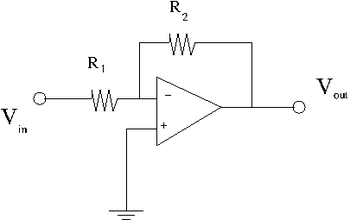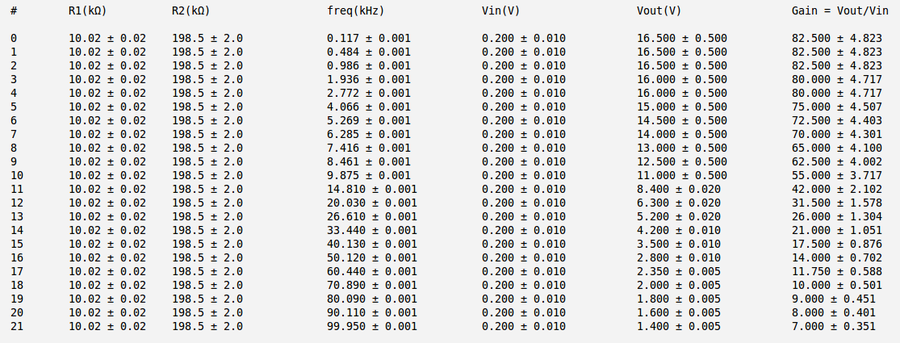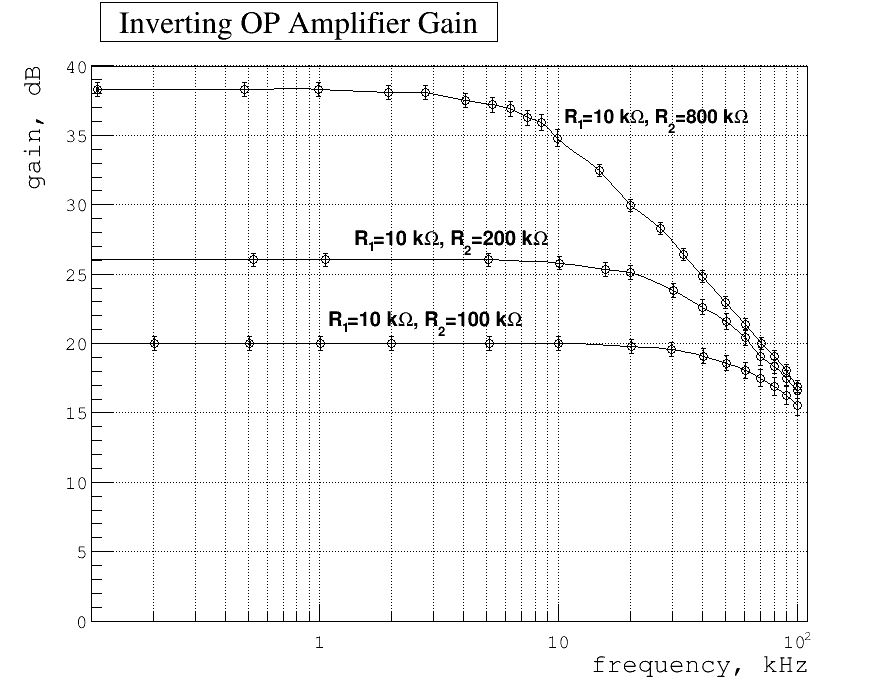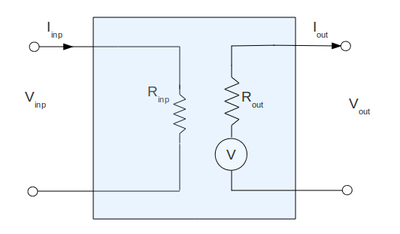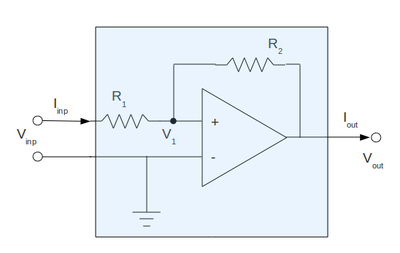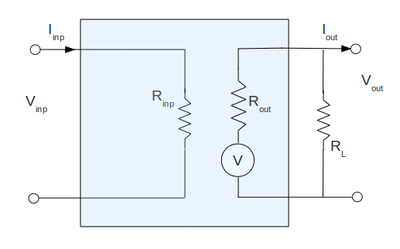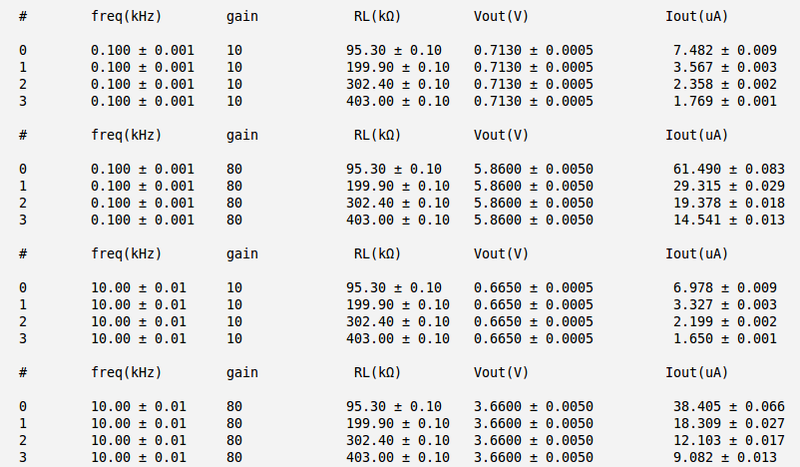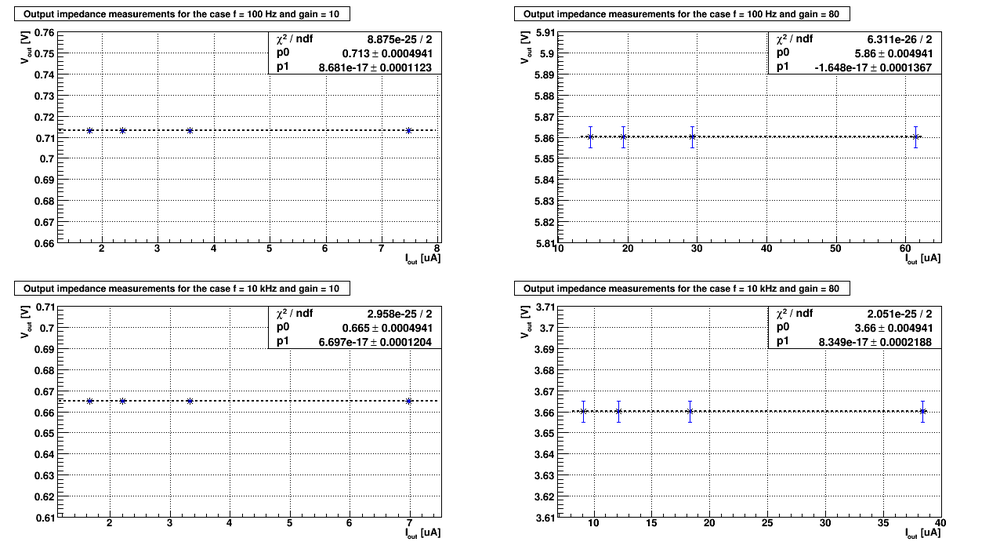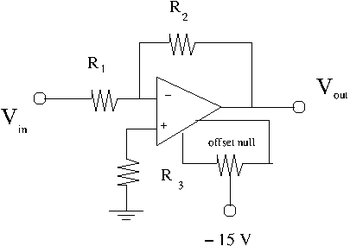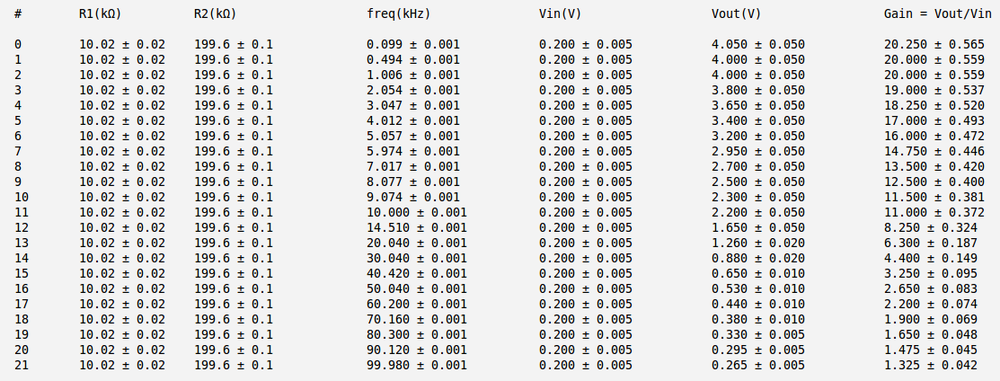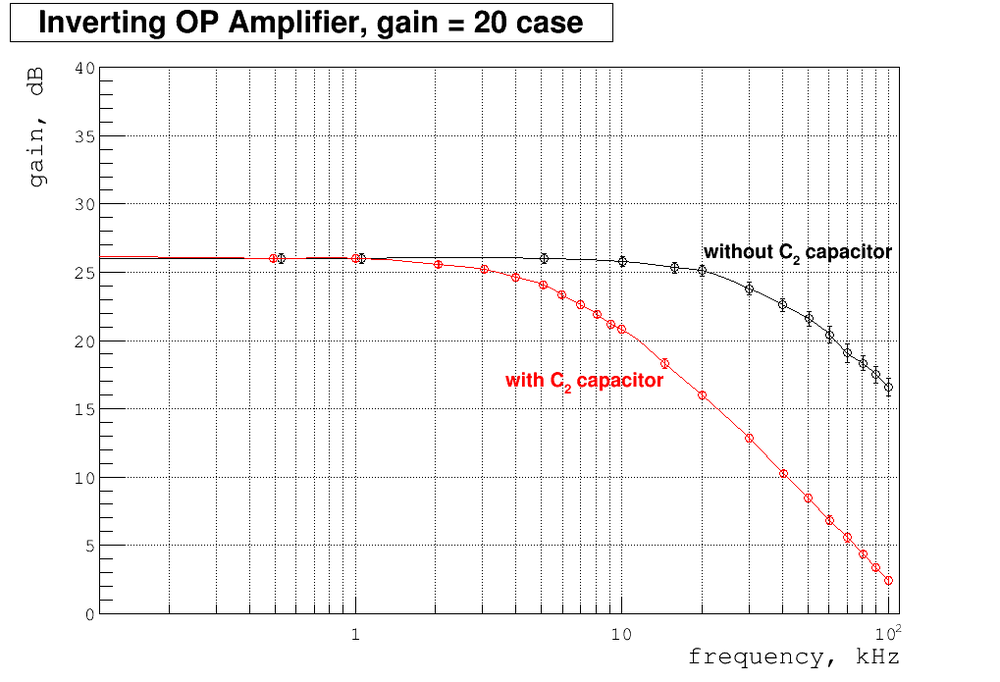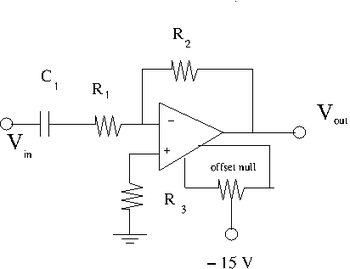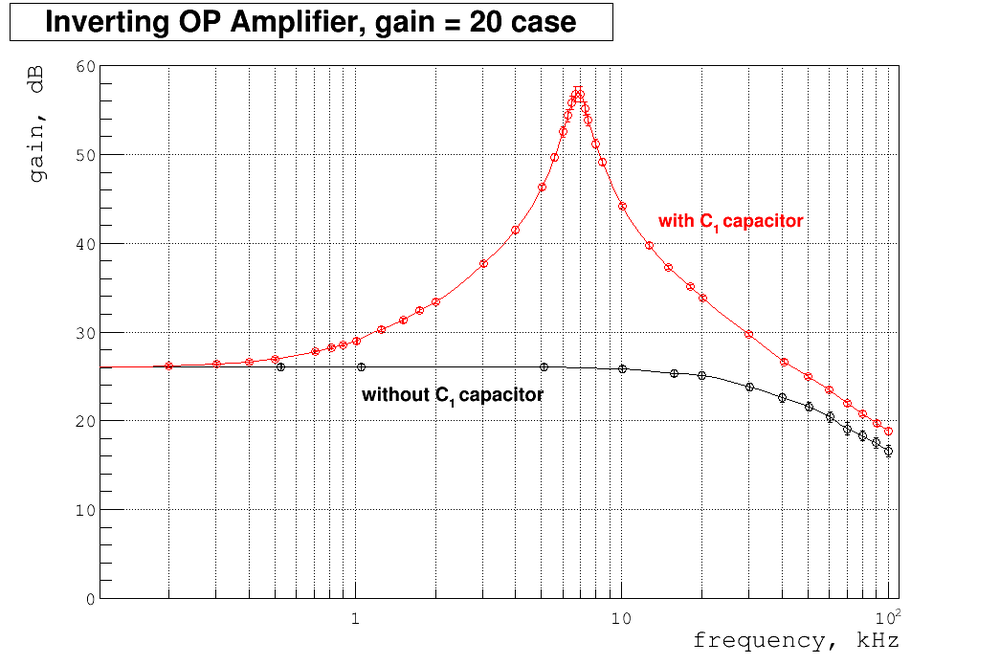Difference between revisions of "Lab 23 RS"
| Line 321: | Line 321: | ||
| − | As we can see the gain starts to go up at about 1 kHz, reaches maximum at about 7 kHz and then goes down. | + | As we can see the gain starts to go up at about 1 kHz, reaches maximum at about 7 kHz and then goes down. It can be understood as follow. At break point frequency calculated above the capacitor <math></math> starts to conduct the AC signal very well. So we are effectively reduce the <math>R_1</math> resistor values and as follow increase the gain = <math>\frac{R_2}{R_1}</math>. As frequency goes up the competing process of decreasing gain starts to work. And at some point the total gain starts to go down. |
=Slew rate= | =Slew rate= | ||
Revision as of 04:03, 22 April 2011
Inverting OP Amp
1. Construct the inverting amplifier according to the wiring diagram below.
Here is the data sheet for the 741 Op Amp
Use and as starting values.
2. Insert a 0.1 F capacitor between ground and both Op Amp power supply input pins. The Power supply connections for the Op amp are not shown in the above circuit diagram, check the data sheet.
Gain measurements
1.) Measure the gain as a function of frequency between 100 Hz and 2 MHz for three values of = 10 k, 100 k, 1M. Keep at .
I have used the following values of and (as was suggested by Dr Forrest at the lecture)
a) b) c)
So my theoretical gain of OP Amp would be:
a) Gain1
b) Gain2
c) Gain3
Below is my measurements and gain calculation for the case a) and
Below is my measurements and gain calculation for the case b) and
Below is my measurements and gain calculation for the case c) and
2.) Graph the above measurements with the Gain in units of decibels (dB) and with a logarithmic scale for the frequency axis.
Below my plot of gain as function of frequency. Here
Here the error calculation as usual and for this specific case is:
where and are corresponding gain and error of gain from the tables above
Impedance
Input Impedance
- Measure for the 10 fold and 100 fold amplifier at ~100 Hz and 10 kHz frequency.
I am going to measure the input and output impedance of my amplifier using the following equivalent circuit:
where the shaded region is my actual amplifier constructed before:
From equivalent circuit the input impedance is:
and from my real circuit inside the shaded region:
so finally my input impedance becomes:
Below is the table with my measurements and input impedance calculations for four asked different cases. Here I have used the meter instead of oscilloscope to reduce the error in my measurements of input voltage.
As we can see the input impedance equals the resistor value for low frequency and increase up to for high frequency .
Output Impedance
- Measure for the 10 fold and 100 fold amplifier at ~100 Hz and 10 kHz frequency. Be sure to keep the output () undistorted
Again the equivalent circuit I am going to use is:
And my output impedance is:
But now I am going to use the load resistor to measure the output circuit:
By graphing the current on the x-axis and the measured voltage on the y-axis for several values of the load resistance we can find the output internal impedance of our amplifier as the slope of the line
Below are my measurements and current calculation for different cases. Here I have used the meter instead of oscilloscope to reduce the error in my measurements of output voltage.
Below are the plots of the as function of
As it follows from the plots above the output impedance (the slope of the line) are:
1) 10 fold amplifier at ~100 Hz frequency: 2) 10 fold amplifier at ~10 kHz frequency: 3) 80 fold amplifier at ~100 Hz frequency: 3) 80 fold amplifier at ~10 kHz frequency:
As we can see the output impedance is essentially the zero. Unfortunately the calculated error is up to . To get the better results I need dramatically improve my measurements, and particularly, improve the measured error in
and
Use the above equation and two measurements of , , and to extract and . I will use two different values of to make two different measurements. =0 (grounded).
Below are my measurements. I have used the meter instead of oscilloscope to reduce my measured error in measured small output voltage.
1) , : 2) , :
Now I can construct 2 equations with 2 unknowns and .
or
with given in Volts and given in Amperes.
To solve these equations will use the matrix method. Let's do it in general to be able to handle the error propagation. We have:
and the two solutions are:
- :
Substituting the corresponding coefficients:
and by doing math and handling the error propagation we find:
Now we will put in a pull up resistor (measured) as shown below.
I have constructed from two resistor in parallel identical to my and used in my initial circuit.
a) (measured) b) (measured)
Instead of the current we have the current
Use the same technique and resistors from the previous section to construct 2 equations and 2 unknowns and extract , keep =0.
Below are my measurements. I have used the meter instead of oscilloscope to reduce my measured error in measured small output voltage. .
1) ,,: , 2) ,,: ,
and to equations becomes:
with given in Volts and given in Amperes.
Substituting the corresponding coefficients into general solutions derived above:
and by doing math and handling the error propagation we find:
So by properly choosing the resistor values I was able to reduce my input offset current from about (case without ) down to about (case with ). By doing that I did my amplifier more perfect (input current for perfect OP AMP is zero). Unfortunately my error for becomes compared with the calculated values of the quantity by itself. But that is because the used method was (the error really comes from the solution of equations). Probably using different method to calculate , for example using scope to measure input voltage and current, we can reduce the measured error. But even with error calculated above we can clearly see the relative reductions of the input offset circuit.
The offset Null Circuit
1) Construct the offset null circuit above.
I have used the gain 20 case with resistors values from previous section:
, ,
2) Adjust the potentiometer to minimize with .
3) Use a scope to measure the output noise.
My initial values of was . Using potentiometer I was able to reduce my up to zero values. Basically doing that I have reduced my input offset voltage so my amplifier becomes more perfect.
My measured output noise at this point becomes:
It's difficult to see the noise reduction because my relative compensation of was small. But if I will start with big initial (for example by adjusting potentiometer) we can observe that noise becomes smaller as we reduce the absolute value of
Capacitors
- Revert back to the pull up resistor
Capacitor in parallel with
1) Select a capacitor such that when = 10 kHz.
I will pick up:
so my break point becomes:
2) Add the capacitor in parallel to so you have the circuit shown above. 3) Use a pulse generator to input a sinusoidal voltage 4) Measure the Gain as a function of the frequency and plot it.
Below my measured voltages and gain calculation.
Below my plot of gain as function of frequency. Also I overplay here my previous measurements of gain without capacitor .
As we can see the gain are dropping down at about calculated above frequency. It's can be easily understood. At this point the capacitor starts to conduct AC signal reducing the effective resistors value. So at hight frequency the gain = starts to drop below the usual value without capacitor. It's sometimes very useful because by decreasing the gain at high frequencies we can prevent unwanted possible oscillations at this point ,
Capacitor in series with
1) Select a capacitor such that when = 1 kHz.
I will pick up:
(can compose like 10nF || (10nF + 10nF))
and my break point becomes:
2) Add the capacitor in series to so you have the circuit shown above. 3) Use a pulse generator to input a sinusoidal voltage 4) Measure the Gain as a function of the frequency and plot it.
Below my measurements and gain calculation:
Below my plot of gain as function of frequency. Also I overplay here my previous measurements of gain without capacitor .
As we can see the gain starts to go up at about 1 kHz, reaches maximum at about 7 kHz and then goes down. It can be understood as follow. At break point frequency calculated above the capacitor starts to conduct the AC signal very well. So we are effectively reduce the resistor values and as follow increase the gain = . As frequency goes up the competing process of decreasing gain starts to work. And at some point the total gain starts to go down.
Slew rate
Measure the slew and compare it to the factory spec.
Power Supply Rejection Ratio
- Set = 0.
- Measure while changing
Output voltage RMS noise
Go Back to All Lab Reports Forest_Electronic_Instrumentation_and_Measurement
